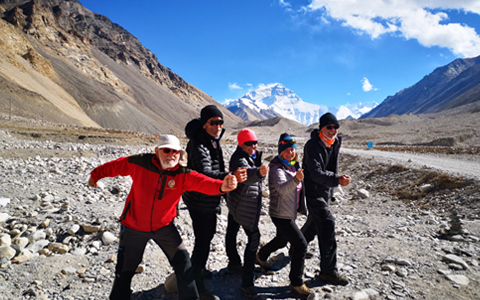Rumors have prevailed that winter is a bad time to tour Tibet, with many believing it’s unbearably cold, with frozen lakes and chilly winds. But is this true? Of course not! In fact, Tibet in winter is not as harsh as imagined. Winter in Tibet is truly worth experiencing, and here are ten compelling reasons to take a winter tour.
Reason 1: Tibet is Not That Cold in Winter.
A larger number of visitors prefer to visit Tibet in summer because they consider it extremely cold in winter due to the high altitude. Actually, winter in Tibet is not as cold as many imagine, especially in Lhasa.
 Lhasa is sunny in winter, and the Potala Palace shines even more brightly during this season.
Lhasa is sunny in winter, and the Potala Palace shines even more brightly during this season.Lhasa, the capital of the Tibet Autonomous Region, is located at a latitude of 29°north. It is warmer than many northern cities in China during the winter months, such as Beijing. In winter (from December to February), although temperatures in Lhasa can drop to about -10℃ at night, the average daytime temperature ranges from 7℃ to 9℃.
Moreover, it seldom rains or snows in winter in Tibet; approximately 90% of days are sunny. Therefore, Tibet experiences more sunshine than many areas of China during the winter months. The bright sunshine and clear skies provide ideal conditions for photography. The average duration of sunshine in Tibet is also relatively long. Lhasa receives 10 to 11 hours of sunlight every day in winter. All of these factors make Tibet's winter less intimidating than many people think.
Reason 2: Oxygen Levels in Winter in Tibet Are Comparable to Summer.
Tibet is located in a high-altitude zone, and its oxygen content is lower than mainland China's. Many people may mistakenly think that the oxygen content decreases during winter. However, in reality, this is not the case. The perceived lack of oxygen in Tibet during winter is just a matter of comfort. Since winter is colder than summer, people feel less comfortable, but this discomfort is not related to oxygen content, which remains basically the same throughout the year.
Taking Lhasa as an example, at an altitude of 3650 meters, there is little difference in oxygen content between winter and summer. Data from the Lhasa Meteorological Bureau indicate that oxygen content in Lhasa is about 66% in summer and around 63% in winter.
Reason 3: Tibet in Winter is Less Crowded.
Compared to peak tourist seasons in Tibet, visiting popular attractions like the Potala Palace and Jokhang Temple in winter offers a peaceful experience without crowds or long lines. You can take your time enjoying the beautiful red and white buildings and the golden roofs of the Potala Palace. With a guide, you can leisurely explore the temples, appreciating the detailed sculptures and murals.
 Drepung Monastery is less crowded in winter.
Drepung Monastery is less crowded in winter.In winter, you'll also avoid queues for photos and long restaurant waits, enjoying a quiet and comfortable atmosphere. This allows for deeper immersion in Tibet's culture and scenery, ensuring a serene and memorable trip.
Reason 4: Tibet in Winter Offers Great Deals!
Price is one of the biggest concerns for most tourists. Summer is the high season for Tibet tourism, making it the most expensive time of year to travel there. Conversely, winter is the most economical season for visiting Tibet, being the off-season for tourism.
Airlines offer considerable discounts ranging from 20% to 50% in winter, while the cost of tourist vehicles is typically two-thirds of their summer rates. Due to fewer visitors, hotels in Tibet also lower their prices to attract guests, often offering better service as well.
 Air tickets to Tibet will be very cheap in winter.
Air tickets to Tibet will be very cheap in winter.Entry fees for many scenic spots are heavily discounted in winter. For instance, the entry fee for the Potala Palace is usually only half of the peak season rate. Furthermore, travel agencies offer discounts to attract tourists during winter. In summary, the cost of a Tibet tour in winter is significantly lower compared to summer.
Reason 5: It’s Easier to Get Permits, Tickets, and Accommodation in Winter.
In winter, fewer tourists travel to Tibet, making it easier to book train tickets, air tickets, and hotels. While many planes and trains operate to Tibet daily, securing tickets can still be challenging during peak seasons, necessitating advance reservations. However, such issues are rarely encountered in winter.
Additionally, for foreign tourists planning a trip to Tibet, obtaining a Tibet Travel Permit before arrival is mandatory. This permit is required when boarding trains or planes bound for Tibet. During winter, as the Tibet Tourism Bureau in Lhasa handles fewer permit applications at a time, the processing time for obtaining the permit may be shorter.
 Obtaining a Tibet Travel Permit can be quicker in winter.
Obtaining a Tibet Travel Permit can be quicker in winter.Reason 6: One Can Experience Authentic Tibetan Culture Among More Pilgrims.
In winter, more pilgrims make their pilgrimage to Lhasa. They devoutly walk along the prayer paths, bow their heads in prayer, and participate in rituals with deep reverence. This creates an atmosphere that feels like being immersed in an ocean of religious devotion.
In temples across Tibet, large and small, the chanting of scriptures, fluttering prayer flags, and flickering butter lamps create a spiritual ambiance. In such settings, you can fully immerse yourself in the authentic atmosphere of Tibetan religious culture.
 Taking a photo with local Tibetan monks while visiting Tibet in winter.
Taking a photo with local Tibetan monks while visiting Tibet in winter.Reason 7: Winter in Tibet is Ideal for Bird Watching.
When the cold winter arrives, thousands of migratory birds move down from Northern Asia to spend a warm season in Tibet. They primarily gather in and around Lhasa, including locations such as the Lhasa River, the Lalu Wetlands, Zongjiao Lukang Park, and the Hutoushan Reservoir in Lhünzhub County. They can also be spotted along the route from Lhasa to Shigatse, flying and foraging freely. Due to the predominant Tibetan Buddhist beliefs that discourage harm to animals, birds in Tibet are accustomed to being near humans.
For photography enthusiasts, this presents an excellent opportunity to capture the beauty of these birds, made even easier by the fewer tourists during winter.
 Winter is a good time to enjoy birds watching in Lhasa.
Winter is a good time to enjoy birds watching in Lhasa.Reason 8: The Snowy Landscape in Winter is Perfect for Sightseeing and Photography.
In winter, Tibet becomes a snow-covered wonderland perfect for stunning photos. During this season, ancient structures like the Potala Palace and Jokhang Temple look even more majestic and mysterious against the snow. Lakes such as Yamdrok and Namtso, with their deep blue waters set against snowy mountains, create beautiful, poetic landscapes.
Tibet's winter air is crisp and clear, offering high visibility that makes sightseeing more enjoyable. You can freely explore the breathtaking snowy plateau and feel the unique charm of this magical land. Whether you are a pilgrim seeking religious culture or a photographer passionate about natural scenery, winter in Tibet offers a rare, peaceful, and beautiful opportunity for exploration.
Reason 9: It’s Easier to See Clear Views of Mount Everest in Winter.
In winter, Tibet enjoys dry and clear weather. Unlike in summer, Mount Everest is rarely covered in clouds, making it easier to enjoy stunning summit views of the world’s highest peak. During this time, you have a better chance to see Mount Everest in all its majestic glory, including beautiful sunsets and sunrises.
While many other high-altitude attractions in Tibet close in winter, Everest Base Camp remains open to visitors. This makes winter a great time to visit Mount Everest Base Camp, allowing you to experience the mystique and beauty of the world's highest peak in a quieter, more peaceful setting.
 It is easier to enjoy stunning summit views of Mount Everest in winter.
It is easier to enjoy stunning summit views of Mount Everest in winter.Reason 10: Winter is a Good Time to Enjoy Traditional Tibetan Festival.
Participating in festivals is one of the best ways to experience local cultures and customs. Winter is an excellent season to enjoy traditional Tibetan festivals.
The Tibetan New Year, celebrated on December 29th in the Tibetan calendar, is a vibrant and pivotal festival, second only to the Shoton Festival. It holds immense cultural significance for Tibetans, marked by rituals like "nine porridge" eating, exorcism activities, and joyous gatherings in festive attire.
 The important Tibetan New Year is held in winter.
The important Tibetan New Year is held in winter.In winter, another significant Tibetan festival is the Lamp Lighting Festival, observed on the 25th day of the 10th month in the Tibetan calendar, commemorating the Parinirvana of the Gelug School's founder. Families honor this day by lighting butter lamps on rooftops and windowsills.
Conclusion
In short, traveling to Tibet in winter is a great idea. Besides the moderate temperatures, you can save money, easily and quickly obtain tickets and permits, celebrate Tibetan traditional festivals, leisurely enjoy stunning scenery, and photograph beautiful wild birds, among other activities. As leading Tibet tour experts with years of experience, we will customize a Tibet winter tour to your preferences. If you still have any questions, please feel free to contact us or book your Tibet tour with us now.

























 Lhasa is sunny in winter, and the Potala Palace shines even more brightly during this season.
Lhasa is sunny in winter, and the Potala Palace shines even more brightly during this season.
 Drepung Monastery is less crowded in winter.
Drepung Monastery is less crowded in winter. Air tickets to Tibet will be very cheap in winter.
Air tickets to Tibet will be very cheap in winter. Obtaining a Tibet Travel Permit can be quicker in winter.
Obtaining a Tibet Travel Permit can be quicker in winter. Taking a photo with local Tibetan monks while visiting Tibet in winter.
Taking a photo with local Tibetan monks while visiting Tibet in winter. Winter is a good time to enjoy birds watching in Lhasa.
Winter is a good time to enjoy birds watching in Lhasa. It is easier to enjoy stunning summit views of Mount Everest in winter.
It is easier to enjoy stunning summit views of Mount Everest in winter. The important Tibetan New Year is held in winter.
The important Tibetan New Year is held in winter.









Ask a Quick Question